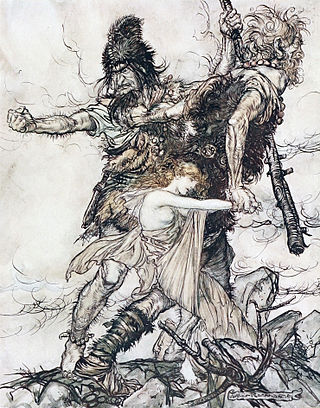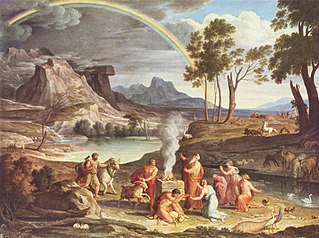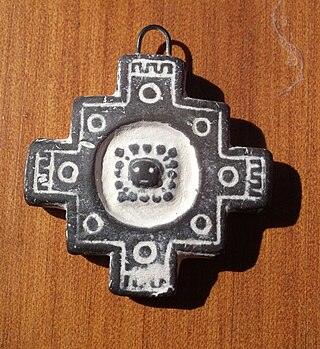Related Research Articles

A dragon is a reptilian legendary creature that appears in the folklore of many cultures worldwide. Beliefs about dragons vary considerably through regions, but dragons in western cultures since the High Middle Ages have often been depicted as winged, horned, and capable of breathing fire. Dragons in eastern cultures are usually depicted as wingless, four-legged, serpentine creatures with above-average intelligence. Commonalities between dragons' traits are often a hybridization of feline, reptilian, and avian features. Scholars believe huge extinct or migrating crocodiles bear the closest resemblance, especially when encountered in forested or swampy areas, and are most likely the template of modern Oriental dragon imagery.

The Tuath(a) Dé Danann, also known by the earlier name Tuath Dé, are a supernatural race in Irish mythology. Many of them are thought to represent deities of pre-Christian Gaelic Ireland.

Parashurama, also referred to as Rama Jamadagnya, Rama Bhargava and Veerarama, is the sixth avatar among the Dashavatara of the preserver god Vishnu in Hinduism. He is believed to be one of the Chiranjeevis (Immortals), who will appear at the end of the Kali Yuga to be the guru of Vishnu's tenth and last incarnation, Kalki.

In folklore, giants are beings of human-like appearance, but are at times prodigious in size and strength or bear an otherwise notable appearance. The word giant is first attested in 1297 from Robert of Gloucester's chronicle. It is derived from the Gigantes of Greek mythology.
The serpent, or snake, is one of the oldest and most widespread mythological symbols. The word is derived from Latin serpens, a crawling animal or snake. Snakes have been associated with some of the oldest rituals known to mankind and represent dual expression of good and evil.

Chinese mythology is mythology that has been passed down in oral form or recorded in literature in the geographic area now known as Greater China. Chinese mythology includes many varied myths from regional and cultural traditions. Much of the mythology involves exciting stories full of fantastic people and beings, the use of magical powers, often taking place in an exotic mythological place or time. Like many mythologies, Chinese mythology has in the past been believed to be, at least in part, a factual recording of history. Along with Chinese folklore, Chinese mythology forms an important part of Chinese folk religion. Many stories regarding characters and events of the distant past have a double tradition: ones which present a more historicized or euhemerized version and ones which present a more mythological version.

Nüwa, also read Nügua, is the mother goddess of Chinese mythology. She is credited with creating humanity and repairing the Pillar of Heaven.

In creation myths, the term "Five Suns" refers to the belief of certain Nahua cultures and Aztec peoples that the world has gone through five distinct cycles of creation and destruction, with the current era being the fifth. It is primarily derived from a combination of myths, cosmologies, and eschatological beliefs that were originally held by pre-Columbian peoples in the Mesoamerican region, including central Mexico, and it is part of a larger mythology of Fifth World or Fifth Sun beliefs.

Gonggong is a Chinese water god who is depicted in Chinese mythology and folktales as having a copper human head with an iron forehead, red hair, and the body of a serpent, or sometimes the head and torso are human, with the tail of a serpent. He is destructive and is blamed for various cosmic catastrophes. In all accounts, Gonggong ends up being killed or sent into exile, usually after losing a struggle with another major deity such as the fire god Zhurong.

The rainbow has been a favorite component of mythology throughout history. Rainbows are part of the myths of many cultures around the world. The Norse saw it as Bifrost; Abrahamic traditions see it as a covenant with God not to destroy the world by means of floodwater. Whether as a bridge to the heavens, messenger, archer's bow, or serpent, the rainbow has been pressed into symbolic service for millennia. There is a myriad of beliefs concerning the rainbow. The complex diversity of rainbow myths are far-reaching, as are their inherent similarities.
Georgian mythology refers to the mythology of pre-Christian Georgians, an indigenous Caucasian ethnic group native to Georgia and the South Caucasus.The mythology of the Kartvelian peoples is believed by many scholars to have formed part of the religions of the kingdoms of Diauehi, Colchis and Iberia.

Philippine mythology is the body of stories and epics originating from, and part of, the indigenous Philippine folk religions, which include various ethnic faiths distinct from one another. Philippine mythology is incorporated from various sources, having similarities with Indonesian and Malay myths, as well as Hindu, Muslim, Shinto, Buddhist, and Christian traditions, such as the notion of heaven, hell, and the human soul. Philippine mythology attempts to explain the nature of the world through the lives and actions of heroes, deities, and mythological creatures. The majority of these myths were passed on through oral tradition, and preserved through the aid of community spiritual leaders or shamans and community elders.

The Thracian religion refers to the mythology, ritual practices and beliefs of the Thracians, a collection of closely related ancient Indo-European peoples who inhabited eastern and southeastern Europe and northwestern Anatolia throughout antiquity and who included the Thracians proper, the Getae, the Dacians, and the Bithynians. The Thracians themselves did not leave an extensive written corpus of their mythology and rituals, but information about their beliefs is nevertheless available through epigraphic and iconographic sources, as well as through ancient Greek writings.

Snakes are a common occurrence in myths for a multitude of cultures. The Hopi people of North America viewed snakes as symbols of healing, transformation, and fertility. In other cultures snakes symbolized the umbilical cord, joining all humans to Mother Earth. The Great Goddess often had snakes as her familiars—sometimes twining around her sacred staff, as in ancient Crete—and they were worshipped as guardians of her mysteries of birth and regeneration. Although not entirely a snake, the plumed serpent, Quetzalcoatl, in Mesoamerican culture, particularly Mayan and Aztec, held a multitude of roles as a deity. He was viewed as a twin entity which embodied that of god and man and equally man and serpent, yet was closely associated with fertility. In ancient Aztec mythology, Quetzalcoatl was the son of the fertility earth goddess, Cihuacoatl, and cloud serpent and hunting god, Maxicoat. His roles took the form of everything from bringer of morning winds and bright daylight for healthy crops, to a sea god capable of bringing on great floods. As shown in the images there are images of the sky serpent with its tail in its mouth, it is believed to be a reverence to the sun, for which Quetzalcoatl was also closely linked.

Kurdish mythology is the collective term for the beliefs and practices of the culturally, ethnically or linguistically related group of ancient peoples who inhabited the Kurdistan mountains of northwestern Zagros, northern Mesopotamia and southeastern Anatolia. This includes their Indo-European pagan religion prior to them converting to Islam or Christianity, as well the local myths, legends and folklore that they produced after becoming Muslims.

Manasa is a Hindu goddess of snakes. She is worshipped mainly in Bihar, Bengal, Jharkhand, Lower Assam and other parts of northeastern India and in Uttarakhand, chiefly for the prevention and cure of snakebite, and also for fertility and prosperity. In Hindu mythology, Manasa is the sister of the first two naga kings, Shesha and Vasuki, and the wife of Sage Jaratkaru. She is the mother of the sage Astika. She is also known as Vishahari, Nityā (eternal) and Padmavati.

Inca mythology or religion includes many stories and legends that attempt to explain or symbolize Inca beliefs.

The mythology of Indonesia is very diverse, the Indonesian people consisting of hundreds of ethnic groups, each with their own myths and legends that explain the origin of their people, the tales of their ancestors and the demons or deities in their belief systems. The tendency to syncretize by overlying older traditions with newer foreign ideas has occurred. For example, the older ancestral mythology might be merged with foreign mythology, such as Hindu, Islam, or Christian biblical mythology.
References
Retrieved: 19 May 2015
Retrieved: 19 May 2015
- ↑ "The Jesup Expedition to the North Pacific Coast". Science. 6 (145): 535–538. 1897. Bibcode:1897Sci.....6..535.. doi:10.1126/science.6.145.535. ISSN 0036-8075. JSTOR 1622723. PMID 17781657.
- ↑ Savill, Sheila (1978). Pears Encyclopaedia of Myths and Legends: Chapter 7. Oceania and Australia. Chapter 8. The Americas. Pelham. p. 212.
- ↑ Dixon-Kennedy, Mike (1998). Native American Myth & Legend: An A-Z of People and Places. Brockhampton Press. p. 194. ISBN 1860198392.
- ↑ Campbell, Joseph (1983). Historical Atlas of World Mythology. A. van der Marck Editions. p. 219.
- ↑ Gray, Louis Herbert (1916). The Mythology of All Races. Marshall Jones Company.